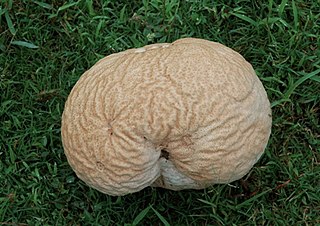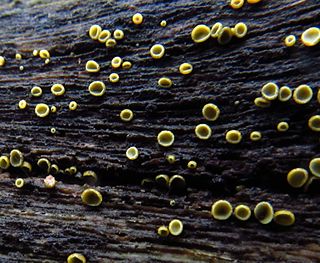
Calvatia is a genus of puffball mushrooms that includes the spectacular giant puffball C. gigantea. It was formerly classified within the now-obsolete order Lycoperdales, which, following a restructuring of fungal taxonomy brought about by molecular phylogeny, has been split; the puffballs, Calvatia spp. are now placed in the family Agaricaceae of the order Agaricales.
Camillea tinctor is a species of fungus in the family Graphostromataceae. It is a plant pathogen and saprophyte of dying or weakened trees such as sycamore, oak, or elm. The fungus causes cankers on large branches or the tree trunk. Ascospores of this fungus are transported by wind or rain that can infect existing wounds in trees. It can be identified by orange staining that can be seen on cut wood, and it has protruding ostioles.

Daedalea is a genus of fungi in the family Fomitopsidaceae. The genus was circumscribed in 1801 by mycologist Christian Hendrik Persoon, based on the type D. quercina and four other species. The generic name is derived from the Ancient Greek δαιδαλεος.

Fomes is a genus of perennial woody fungi in the family Polyporaceae. Species are typically hoof-shaped (ungulate). New growth each season is added to the margin, resulting in a downward extension of the hymenium. This often results in a zonate appearance of the upper surface, that is, marked by concentric bands of color.

Lentinus is a genus of fungi in the family Polyporaceae. The genus is widely distributed, with many species found in subtropical regions.

The Lichinaceae are a family of ascomycete fungi. Most species are lichenized with cyanobacteria, and have a distribution largely in temperate regions.

Dacryobolus is a genus of crust fungi in the family Fomitopsidaceae. Elias Fries circumscribed the genus in 1849 with Dacryobolus sudans as the type species. Dacryobolus are wood-decay fungi that cause a brown rot.

Chlorosplenium is a genus of fungi in the family Dermateaceae. The genus was circumscribed by Elias Magnus Fries in 1849.
Leprieuria is a genus of fungi in the family Xylariaceae. This is a monotypic genus, containing the single species Leprieuria bacillum.

The Boliniaceae are a family of fungi in the Boliniales order. The family consisted of seven genera and 40 species in 2008. A new study found more genera and species in 2020.

Coriolopsis is a genus of fungi in the family Polyporaceae. It was circumscribed by American mycologist William Alphonso Murrill in 1905. The genus is cosmopolitan, with most species in tropical areas. The generic name combines the name Coriolus with the Ancient Greek word ὄψις ("appearance").
Grammothele is a genus of poroid crust fungi in the family Polyporaceae.

Hexagonia is a genus of poroid fungi in the family Polyporaceae. The genus has a widespread distribution, especially in tropical regions. The generic name is derived from the Latin word hexagonus, meaning "with six angles".
Myriangium is a genus of fungi within the family Myriangiaceae.

Octaviania is a genus of truffle-like fungi in the family Boletaceae. The widespread genus is estimated to contain 15 species.











